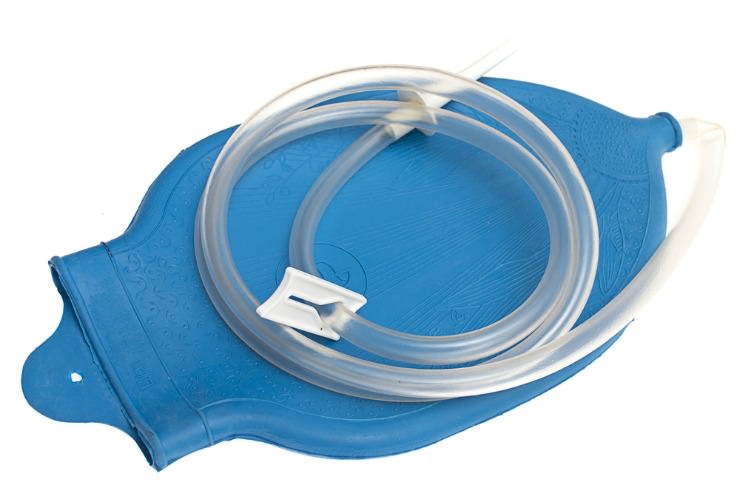
Below are written instructions as well as a how-to video of a Mother who has used at-home fecal transplants to help eliminate her daughter’s debilitating gut problems and get her off strong medications for good.
She demonstrates exactly how to do an at-home fecal transplant using a simple, low-cost enema bottle available over the counter at the pharmacy.
A small study has shown that an at-home fecal transplant using an enema bag to be completely safe and highly effective.
If you feel more comfortable with written instructions, here are directions from Dr. David Williams’ newsletter “How to Perform a Home Fecal Transplant” using an enema bag.
How to Find a Suitable Donor
A suitable fecal donor should not answer yes to ANY of the following contraindications:
- History of Covid shots (they destroy ALL the beneficial bifidobacteria in the gut)
- Symptoms of any gastrointestinal disease.
- Overweight (indicates imbalance of gut flora)
- Malignancy
- History of antibiotic use
- History of birth control pills
- Hospitalization within the past three months
The donor’s blood should be tested for hepatitis A, B, and C, HIV, and syphilis.
In addition, a stool test should be performed to check for pathogens, parasites, and C. difficile.
Typically, a family member is the ideal donor since they have been in close proximity to the patient and share the same infectious risk factors, which minimizes risk.
Alternatively, a healthy stool sample can be obtained from the independent stool bank OpenBiome located in Massachusetts. I am not sure if OpenBiome screens out donors who have had any Covid shots, so it would be wise to ask first.
Items Needed for DIY Fecal Transplant
To perform the procedure, you need the following items in addition to a fresh stool sample:
- A therapeutic probiotic should be taken before the transplant by the patient (not the donor), and for at least 60 days following. I suggest staying on it for life.
- A four-day prescription taken by the patient for metronidazole (Flagyl) 500 mg (orally three times per day), or vancomycin 125 mg (orally four times per day) to sterilize or wipe out any pathogenic bacteria in the colon. The medication needs to be stopped 24 to 48 hours before the procedure. [Grant Pharmacy online can mail order this to you without a script.]
- At least 200 mL of normal sterile saline solution (found at any pharmacy or online).
- A standard 2-quart enema bag kit.
- A kitchen blender.
The best time to perform the procedure is in the morning following the first bowel movement of the day.
- Combine 50 mL of solid stool obtained from the donor immediately before the transplant (less than 30 minutes) with a 200 mL saline solution in the blender.
- Mix in the blender until liquefied.
- Pour the entire mixture into the enema bag.
Have the patient lie on the left side and administer the enema per kit instructions. The patient should remain in that position for as long as possible to avoid defecation.
The patient should not feel any pain or discomfort outside of the normal sensations experienced during an enema.
If diarrhea occurs within one hour, the procedure can be immediately repeated, but a fresh stool sample will need to be used.
How-to Video: Home Fecal Transplant
The video below was filmed by a Mother doing a home fecal transplant for her daughter who is debilitated by gut problems.
Note that the sound is not the best, but it is the best I’ve found to share.
References
OpenBiome: Independent Stool Bank
One Person’s Poop is Another Person’s Prescription
As Antibiotic Failure Grows, Poop Pills Filling the Void
Gastroenterologist Reveals Covid (and Jab) Effects on Gut MicroBiome
Success of self-administered home fecal transplantation for chronic Clostridium difficile infection


Thank you for posting this video. Wanting to do the same for my husband who is suffering from C Diff. Just finished second round of Vancomycin & the fecal pills but not sure it has done any good. Also wondering why have you had to do this for your daughter for 9 months. Will you be able to stop doing it soon?
It’s not my daughter … I was posting a video of another Mother and the method she used. I don’t know how to get in contact with her as the video is from many years ago and the best I have found that is still available for viewing.
God bless you for putting this out there. From the depths of society’s soul. Thank you
Very interesting !
Sarah, I am not sure when you posted these articles about fecal transplants but I would think that these independent stool banks would no longer be a good choice in light of the Covid jabs. I wonder if there are any vaccine/jab free stool banks ?
I couldn’t hear most of what was said… Half the time your voice was so low, very hard to understand..
It’s the best out there that I’ve been able to find … try using headphones to hear it better.
how do you choose a donor??
A healthy immediate family member is ideal.
How is your friend doing now?
Thank You, my friend has c-diff and after three antibiotic treatments it keeps coming back, and is probably going to kill him, or cause him to lose his colon. This sounds promising, because he can’t afford to go to a hospital for it.